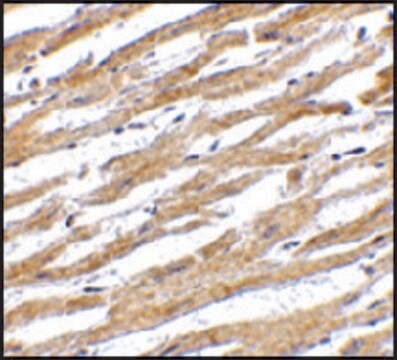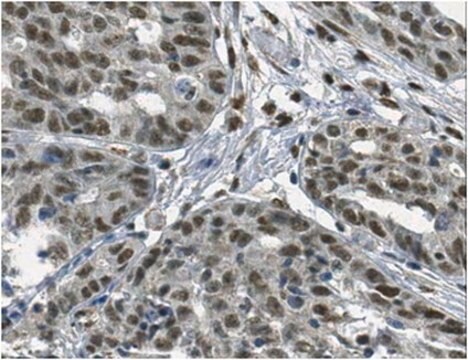MAB874
Anti-Papillomavirus Antibody, 16, 18 E6 protein, clone C1P5
clone C1P5, Chemicon®, from mouse
Synonym(e):
HPV
About This Item
Empfohlene Produkte
Biologische Quelle
mouse
Qualitätsniveau
Antikörperform
purified immunoglobulin
Antikörper-Produkttyp
primary antibodies
Klon
C1P5, monoclonal
Speziesreaktivität
human
Hersteller/Markenname
Chemicon®
Methode(n)
immunohistochemistry: suitable
western blot: suitable
Isotyp
IgG
Versandbedingung
wet ice
Allgemeine Beschreibung
Spezifität
Immunogen
Anwendung
Infektionskrankheiten
Virale Infektionskrankheiten
Immunohistochemistry: Shows reactivity on formalin fixed tissue. Dilute with buffer pH 7.5-8.0 to desired working volumes. For extensive dilution, protein containing or other stabilizing medium should be used.
Immunopreciptiation: Immunoprecipiates 16.5 kDa band from human cervical carcinoma extracts {Banks, et al, 1987}.
Final working dilutions must be determined by end user.
Zielbeschreibung
Physikalische Form
Lagerung und Haltbarkeit
Hinweis zur Analyse
Human cervical carcinoma extract
Sonstige Hinweise
Rechtliche Hinweise
Haftungsausschluss
Sie haben nicht das passende Produkt gefunden?
Probieren Sie unser Produkt-Auswahlhilfe. aus.
Lagerklassenschlüssel
12 - Non Combustible Liquids
WGK
WGK 2
Flammpunkt (°F)
Not applicable
Flammpunkt (°C)
Not applicable
Analysenzertifikate (COA)
Suchen Sie nach Analysenzertifikate (COA), indem Sie die Lot-/Chargennummer des Produkts eingeben. Lot- und Chargennummern sind auf dem Produktetikett hinter den Wörtern ‘Lot’ oder ‘Batch’ (Lot oder Charge) zu finden.
Besitzen Sie dieses Produkt bereits?
In der Dokumentenbibliothek finden Sie die Dokumentation zu den Produkten, die Sie kürzlich erworben haben.
Unser Team von Wissenschaftlern verfügt über Erfahrung in allen Forschungsbereichen einschließlich Life Science, Materialwissenschaften, chemischer Synthese, Chromatographie, Analytik und vielen mehr..
Setzen Sie sich mit dem technischen Dienst in Verbindung.



![2-(2-Azabicyclo[2.2.1]hept-2-yl)ethanol AldrichCPR](/deepweb/assets/sigmaaldrich/product/structures/325/689/6a6eb812-ddc3-4fe3-9dc4-ad0b5caedd35/640/6a6eb812-ddc3-4fe3-9dc4-ad0b5caedd35.png)


